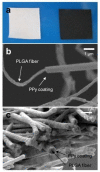Surface Modification Progress for PLGA-Based Cell Scaffolds
- PMID: 38201830
- PMCID: PMC10780542
- DOI: 10.3390/polym16010165
Surface Modification Progress for PLGA-Based Cell Scaffolds
Abstract
Poly(lactic-glycolic acid) (PLGA) is a biocompatible bio-scaffold material, but its own hydrophobic and electrically neutral surface limits its application as a cell scaffold. Polymer materials, mimics ECM materials, and organic material have often been used as coating materials for PLGA cell scaffolds to improve the poor cell adhesion of PLGA and enhance tissue adaptation. These coating materials can be modified on the PLGA surface via simple physical or chemical methods, and coating multiple materials can simultaneously confer different functions to the PLGA scaffold; not only does this ensure stronger cell adhesion but it also modulates cell behavior and function. This approach to coating could facilitate the production of more PLGA-based cell scaffolds. This review focuses on the PLGA surface-modified materials, methods, and applications, and will provide guidance for PLGA surface modification.
Keywords: PLGA; cell adhesion; cell delivery; cell scaffold; surface modification.
Conflict of interest statement
The authors declare no conflicts of interest.
Figures













Similar articles
-
Mesoporous bioactive glass surface modified poly(lactic-co-glycolic acid) electrospun fibrous scaffold for bone regeneration.Int J Nanomedicine. 2015 Jun 2;10:3815-27. doi: 10.2147/IJN.S82543. eCollection 2015. Int J Nanomedicine. 2015. PMID: 26082632 Free PMC article.
-
Triple PLGA/PCL Scaffold Modification Including Silver Impregnation, Collagen Coating, and Electrospinning Significantly Improve Biocompatibility, Antimicrobial, and Osteogenic Properties for Orofacial Tissue Regeneration.ACS Appl Mater Interfaces. 2019 Oct 16;11(41):37381-37396. doi: 10.1021/acsami.9b07053. Epub 2019 Oct 7. ACS Appl Mater Interfaces. 2019. PMID: 31517483 Free PMC article.
-
Enhancement in sustained release of antimicrobial peptide and BMP-2 from degradable three dimensional-printed PLGA scaffold for bone regeneration.RSC Adv. 2019 Apr 4;9(19):10494-10507. doi: 10.1039/c8ra08788a. eCollection 2019 Apr 3. RSC Adv. 2019. PMID: 35515290 Free PMC article.
-
Growth and metabolism of human hepatocytes on biomodified collagen poly(lactic-co-glycolic acid) three-dimensional scaffold.ASAIO J. 2006 May-Jun;52(3):321-7. doi: 10.1097/01.mat.0000217794.35830.4a. ASAIO J. 2006. PMID: 16760723
-
Recent advances in PLGA-based biomaterials for bone tissue regeneration.Acta Biomater. 2021 Jun;127:56-79. doi: 10.1016/j.actbio.2021.03.067. Epub 2021 Apr 6. Acta Biomater. 2021. PMID: 33831569 Review.
Cited by
-
Mechanisms of tendon-bone interface healing: biomechanics, cell mechanics, and tissue engineering approaches.J Orthop Surg Res. 2024 Dec 3;19(1):817. doi: 10.1186/s13018-024-05304-8. J Orthop Surg Res. 2024. PMID: 39623392 Free PMC article. Review.
-
Advancements in Bone Replacement Techniques-Potential Uses After Maxillary and Mandibular Resections Due to Medication-Related Osteonecrosis of the Jaw (MRONJ).Cells. 2025 Jan 20;14(2):145. doi: 10.3390/cells14020145. Cells. 2025. PMID: 39851573 Free PMC article. Review.
-
Scaffold-mediated liver regeneration: A comprehensive exploration of current advances.J Tissue Eng. 2024 Oct 13;15:20417314241286092. doi: 10.1177/20417314241286092. eCollection 2024 Jan-Dec. J Tissue Eng. 2024. PMID: 39411269 Free PMC article. Review.
-
Innovative Bioscaffolds in Stem Cell and Regenerative Therapies for Corneal Pathologies.Bioengineering (Basel). 2024 Aug 23;11(9):859. doi: 10.3390/bioengineering11090859. Bioengineering (Basel). 2024. PMID: 39329601 Free PMC article. Review.
References
Publication types
LinkOut - more resources
Full Text Sources

